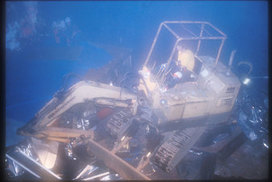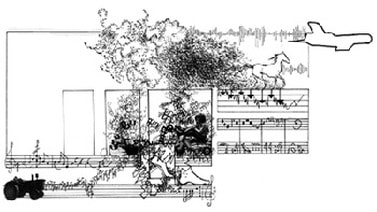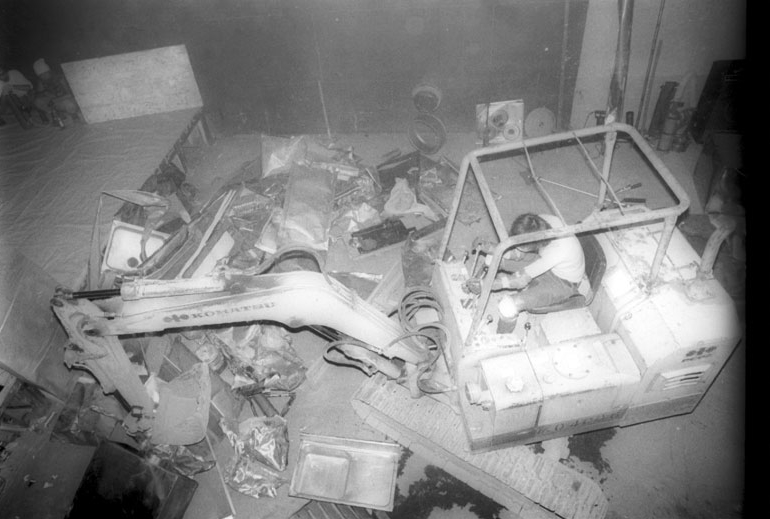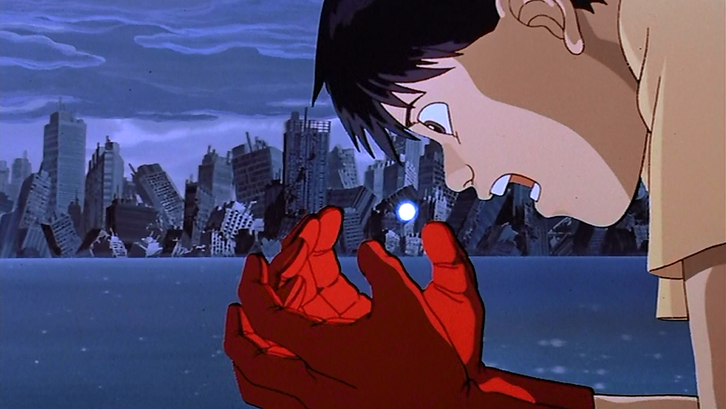|
This article was originally published in Litro magazine issue 151 - Adrenaline How do you get from the tritone as "the devil in music" to an audience facing a wall of white noise with smiles on their faces? “It's amazing, really, how little sound comes out of something you're smashing with all your might”  Eye on the bulldozer, photo by GinSatoh Eye on the bulldozer, photo by GinSatoh The adventurous Noizu fans who came to see crackpot noise-makers Hanatarashi (meaning snot-nosed) at Tokyo's Toritsu Kasei Super Loft on August 4th 1985 expected a raucous show. What they didn't expect was a ferocious performance of industrial-grade destruction with a back-hoe bulldozer as the lead instrument. Handed waivers upon arrival that relieved the band of any responsibility for injury, or worse, the audience watched as frontman and HDV operator Yamatsuka Eye burst through the doors of the hall atop the bulldozer. With percussionist Ikuo Taketani somewhat safely tucked away in the corner, Eye tore through the stage and inflicted brutal punishment on everything nearby, including the literal kitchen sink, while screaming the band's trademark scatological and sexual non-sequitur lyrics. The beleaguered bulldozer held out until Eye put the hoe into the wall. The dozer tipped backwards and gave out, but after pulling off the dozer's cage to hurl across the stage and grabbing a circular saw, the destruction continued with the audience now nervously dodging Eye's fitful saw swings. Surrounded by bent metal, crumbled masonry and the squawking remains of Marshall stacks, with gasoline pouring from the ruined bulldozer, Eye produced, as his grand finale, a molotov cocktail that he'd prepared earlier. This was a touch too dangerous for even this daredevil audience and Eye, confessing later in an interview for Banana Fish Magazine that he got “too excited”, had to be violently subdued by several members of the crowd.
0 Comments
Riots for Stravinsky and cheers for Hanatarashi. How do you get from the tritone as “the devil in music” to an audience facing a wall of white noise with smiles on their faces?
“It’s amazing, really, how little sound comes out of something you’re smashing with all your might” – Yamatsuka Eye The adventurous Noizu fans who came to see crackpot noise-makers Hanatarashi (meaning snot-nosed) at Tokyo’s Toritsu Kasei Super Loft on August 4th 1985 expected a raucous show. What they didn’t expect was a ferocious performance of industrial-grade destruction, with a back-hoe bulldozer as the lead instrument. Handed waivers upon arrival that relieved the band of any responsibility for injury, or worse, the audience watched as frontman and HDV operator Yamatsuka Eye burst through the doors of the hall atop the bulldozer. Read more at Litro
FUNimation release the 25th anniversary edition Blu-Ray/DVD of Katsuhiro Ohtomo's Akira today, a perfect opportunity to celebrate and re-evaluate the classic anime.
Condensing the plot of Otohmo's concurrently ongoing epic manga into a two hour film, the anime proved to be a runaway success and a gateway film for western audiences. The release of Akira in 1988, with the addition of Grave Of The Fireflies and My Neighbour Totoro the same year, marked a new sophistication in Japanese animation and the start of its mainstream success worldwide.
2019: It's been 31 years since Tokyo was reduced to a crater in a sudden flash of light, sparking World War 3. The remains lie as a black hole at the center of the new metropolis, Neo-Tokyo, built on the rubble. The egotistical Kaneda runs the Capsules biker gang, while long-suffering sidekick Tetsuo boils under his inferiority complex. A motorcycle crash after a run-in with an escaped subject of psychic experiments puts Tetsuo in hospital in the custody of the psychic project's leader, Colonel Shikishima, and reveals Tetsuo's own latent psychic powers. Dissident revolutionaries, apocalypse worshipping cultists and a secret government project related to Tokyo's destruction, known as Akira, whirl around the developing emnity between the ever-more powerful Tetsuo and the befuddled Kaneda. Who or what is Akira? Tetsuo seeks answers below Tokyo as he evolves increasingly god-like powers that eventually spiral out of control. The production techniques in Akira were ground-breaking for Japanese animation at the time, making full use of the mammoth $11mill budget and staff of 70 animators. Character's expressions and mouth movements were drawn to pre-scored dialogue, advanced multi-layered perspective was used for depth and sense of scale, and an expanded use of dark colours created authentic night scenes. Standard outlandish anime style was out, as was traditional heroic storytelling, in favour of darker and more realistic art, narrative and characterisation. Akira exploits Japan's specific societal concerns with overcrowding, youth alienation and generational disconnection from the wartime past, but also universal themes of technophobia, adolescence and the cyclical nature of war. Power is the core of the film; who has it and who wants to take it. Japan knows better than any country about the perils of technology and messiah complexes, and fear of power and its seduction pervades the film. Within the tangled web of themes and symbols in Akira is a confrontational allegory of generations, split by World War 2 and the nuclear bomb, that don't understand one another. However, all this grand subject matter in the film is in service to what is, essentially, a fast-paced action blockbuster with a moving story of rivalry and maturation.
Alongside the animation, Akira's soundtrack is another remarkable component. The hundredfold membership musical collective Geinoh Yamashirogumi were commissioned by Ohtomo following the success of their album Ecophony Rinne, which displayed a unique mix of traditional Japanese music and enterprising electronics. Led by artist/scientist Tsutomu Ōhashi, the collective recorded modular pieces based on various themes over six months, without the benefit of scoring to finished scenes. The influences were wide: Nogaku theatre, Buddhist chants, Christian choral, Balinese gamelan, progressive rock. The effect is a startlingly turbulent mix of ancient spiritualism battling modernity, which corresponds perfectly with the themes of the film. The freedom from the limitations of budget, time and scene-matching served the compositions, allowing focus on development of mood over pacing for the film's sequences.
Akira is a frequently baffling, convoluted film that suffers from the same frayed chaos as its setting. Despite this, the film holds together and the rambling strangeness and density are part of its enduring charm.
I think a great double-bill partner for Akira would be Shane Carruth's Upstream Color. Biological manipulation, bewildering puzzle narratives and great soundtracks. Watch them early and you can spend the rest of the night trying to work out what the hell both of them are really about.
For more Katsuhiro Ohtomo animation, watch Construction Suspension Order and Memories, for which Ohtomo directed the section Magnetic Rose.
|
Archives
November 2023
Categories
All
LinksWriting
Art & Design Science Music Film All contributions by Kieran Gosney unless otherwise stated.
© Kieran Gosney and kierangosney.com, 2013. Unauthorized use and/or duplication of this material without express and written permission from this blog’s author and/or owner is strictly prohibited. Excerpts and links may be used, provided that full and clear credit is given to Kieran Gosney and kierangosney.com with appropriate and specific direction to the original content.
|



 RSS Feed
RSS Feed